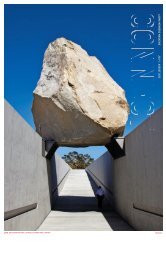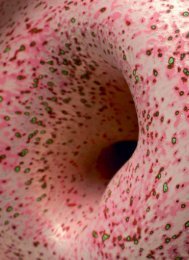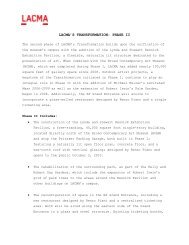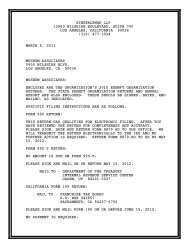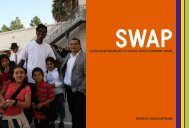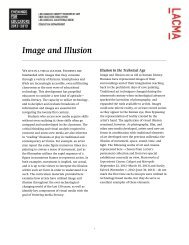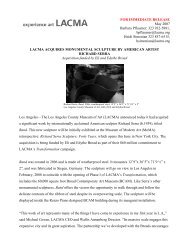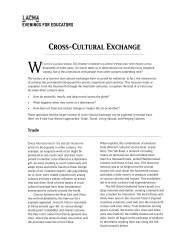LACMA Acquires Two Major Sculptures By Baroque Master
LACMA Acquires Two Major Sculptures By Baroque Master
LACMA Acquires Two Major Sculptures By Baroque Master
Create successful ePaper yourself
Turn your PDF publications into a flip-book with our unique Google optimized e-Paper software.
^<br />
For immediate release<br />
<strong>LACMA</strong> ACQUIRES TWO MAJOR SCULPTURES BY BAROQUE MASTER<br />
GIOVANNI BARATTA<br />
(image caption on page 3)<br />
(Los Angeles, December 1, 2011)— The Los Angeles County Museum of Art has<br />
acquired two life-size allegorical figure statues by the late Florentine<br />
<strong>Baroque</strong> master, Giovanni Baratta (1640–1747). The rediscovery of these<br />
sculptures, Wealth and Prudence, has been recognized as a major<br />
contribution to the study of early eighteenth-century Florentine art. The<br />
works are generous gifts to the museum by long-time benefactor, The<br />
Ahmanson Foundation, which has contributed extensively to the development<br />
of <strong>LACMA</strong>’s collection of European Painting and Sculpture over the last<br />
forty years. The sculptures are on view on the third floor of the Ahmanson<br />
Building, in the recently reinstalled European galleries.<br />
Originally part of one of the artist's most illustrious commissions, the<br />
works are noted for their refined elegance. The sculptures were<br />
commissioned by Niccolò Maria Giugni (1672-1717) for the gallery in his<br />
Palazzo on the Via degli Alfani in Florence. Facing one another at either<br />
end of the gallery, they were part of an elaborate iconographic scheme<br />
intended to glorify the Medici family and celebrate the Giugni family’s<br />
allegiance to the Medici. The choice of Wealth and Prudence was<br />
particularly appropriate to illustrate the joint virtues of the families,
as some members of the Giugni family had advised the Medici in various<br />
aspects of their governance.<br />
The two allegories closely match the iconology of the subjects: Wealth is<br />
a woman bedecked with jewels and holding a crown in one hand, a scepter in<br />
the other (the scepter may either have disappeared or never have been<br />
intended by the sculptor); Prudence is identified by the mirror she's<br />
holding as well as an arrow and eel, all of which appear distinctly in<br />
Baratta's sculpture. In addition to their size, the extraordinary quality<br />
of carving in the sculptures is especially noteworthy. Of particular<br />
beauty are the hands whose fingers delicately press the fabrics, and folds<br />
that are thinly and sharply executed in a way that carries into the<br />
eighteenth century tradition of Bernini, in whose studio Baratta's uncle<br />
had worked. The sculptures were executed shortly before 1709, at the<br />
height of Baratta's fame. Shortly after, with well-established<br />
international recognition, he received commissions globally, including<br />
those from the Duke of Marlborough ("Princely Glory," Cambridge,<br />
Fitzwilliam Museum), the King of Denmark (“Peace,” Fedensborg Castle), and<br />
the Royal House of Savoy in Turin (Decoration of the Church of St. Hubert<br />
in the Venaria Reale).<br />
As the first marble examples of <strong>Baroque</strong> Florentine sculpture to enter the<br />
collection, Wealth and Prudence are important additions to <strong>LACMA</strong>’s<br />
extensive grouping of late seventeenth- and early eighteenth-century<br />
Florentine sculpture. The Baratta works join bronzes by Montauti, as well<br />
as a gilded terra-cotta, a wax relief, and medals by Massimo Soldani-Benzi,<br />
amongst other notable works in the museum’s permanent collection.<br />
About <strong>LACMA</strong><br />
Since its inception in 1965, <strong>LACMA</strong> has been devoted to collecting works of art that<br />
span both history and geography and represent Los Angeles's uniquely diverse<br />
population. Today, the museum features particularly strong collections of Asian, Latin<br />
American, European, and American art, as well as a contemporary museum on its campus.<br />
With this expanded space for contemporary art, innovative collaborations with artists,<br />
and an ongoing Transformation project, <strong>LACMA</strong> is creating a truly modern lens through<br />
which to view its rich encyclopedic collection.<br />
Location and Contact: 5905 Wilshire Boulevard (at Fairfax Avenue), Los Angeles, CA,<br />
90036 | 323 857-6000 | lacma.org<br />
Hours: Monday, Tuesday, Thursday: noon-8 pm; Friday: noon-9 pm; Saturday, Sunday: 11<br />
am-8 pm; closed Wednesday<br />
General Admission: Adults: $15; students 18+ with ID and senior citizens 62+: $10<br />
2
Free General Admission: Members; children 17 and under; after 5 pm weekdays for L.A.<br />
County residents; second Tuesday of every month; Target Free Holiday Mondays<br />
Image (page 1)<br />
(Left) Giovanni Baratta (1640-1747), Pair of Allegorical Figures – Wealth and Prudence,<br />
c. 1703-08, photo © 2011 Museum Associates/<strong>LACMA</strong><br />
Press Contact: For additional information, contact <strong>LACMA</strong> Communications at<br />
press@lacma.org or 323 857-6522.<br />
# # #<br />
3



